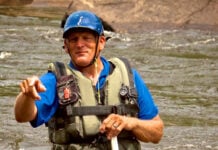An avid surfer from the age of 13, Scott Johnson thrived in the water. “I don’t remember a time of my life that the beach wasn’t there,” he says in the 2024 documentary, Double or Nothing.
It was also prolonging his life; the ocean air helped loosen the mucus building up in his lungs, a symptom of cystic fibrosis (CF) that makes it difficult for patients to breathe.
Racing 80 miles on borrowed lungs
It wasn’t until Johnson was 29 his health began to fail. Bedridden for two months, he began contemplating suicide. But he received a second chance in the form of a double lung transplant.
Since then, he’s attempted seven Ironman triathlons, successfully completing one. In 2022, on the 20-year anniversary of his lung transplant, he attempted to paddleboard 80 miles from the Bahamas to Florida as part of the Crossing, an annual fundraiser for patients and families struggling with CF. In doing so, he became the first double lung transplant survivor to take on the challenge.

Paddling Magazine: Where did you first hear about the Crossing?
Scott Johnson: I was at a paddleboard race called the Carolina Cup in Wilmington, North Carolina. I was hyping up some friends who were racing, while my wife toured the expo. She met Piper’s Angels. She found me and said, “You have to talk to these people. They’re insane. They do a race from the Bahamas to Florida—and it’s all for cystic fibrosis.”
I was like, “Yeah, that’s pretty crazy.” But in my mind, I thought: “That is just my kind of crazy.”
PM: Who is Piper?
SJ: Piper is the daughter of Travis Suit. He founded Piper’s Angels—the nonprofit behind the Crossing for Cystic Fibrosis—when she was diagnosed with CF at age four. When I first met Travis and told him my story, it hit him in a profound way. When I was born in 1972, the average life expectancy for someone with CF was two. I told him having CF isn’t a death sentence. Miracles can happen. And when I looked up, he was crying. In meeting me, he saw what was possible for children with CF.
PM: What challenges does paddling with borrowed lungs present?
SJ: I’m good at maintaining a steady pace and can go all day, which is why I’ve gravitated to endurance events. But I’m not very fast. Anytime speed gets introduced into the mix, my whole body just falls apart.
On the day of the Crossing in 2022, there was no wind. Usually, the prevailing winds give you some help across. The water was so calm, it felt like an oven. My team realized we wouldn’t make the cutoff time at our pace of 3.5 miles per hour and would have to double our speed. I knew I couldn’t maintain it, so I had to call it quits around mile 43. I do a lot of crazy stuff, but I never put my health in such jeopardy it might end my life.
PM: Why do you push yourself?
SJ: The progression is you can do longer, you challenge yourself, and you keep going. I push the lungs I have to the absolute limit because it is a gift I don’t want to waste.
PM: When are you attempting the Crossing again?
SJ: The Crossing is much harder than any Ironman I’ve ever done. With an Ironman, the distances are extreme, but there are three different disciplines. With the Crossing, it’s just paddling, so you have to be mentally prepared. There’s a saying in the endurance community: you learn more from your failures than your victories. I finished the Crossing as part of a relay team in 2023, but I’m going back in 2025 to try and do it solo.
Watch the documentary film Double or Nothing on YouTube.
Scott Johnson (third from front) with his team in the Crossing in 2023. The Crossing begins at midnight and takes most participants between 12 and 15 hours to finish. | Feature photo: David Scarola




 This article was first published in Issue 72 of Paddling Magazine.
This article was first published in Issue 72 of Paddling Magazine. 




